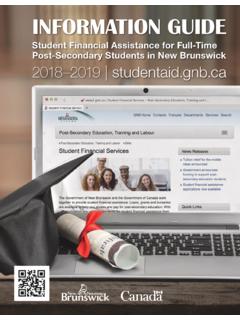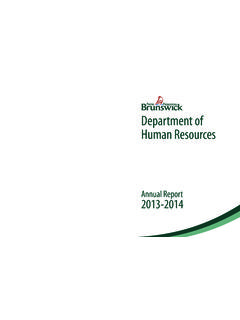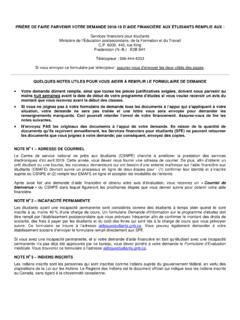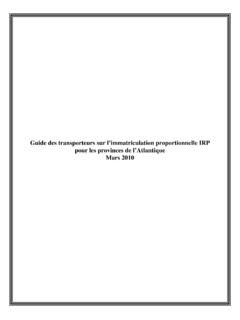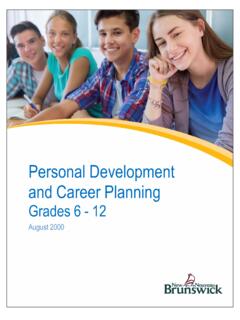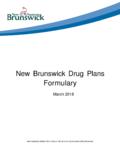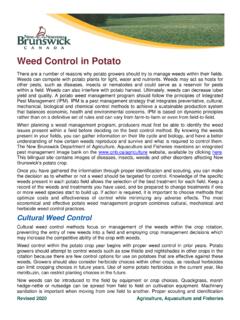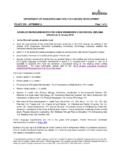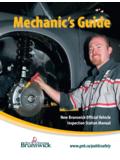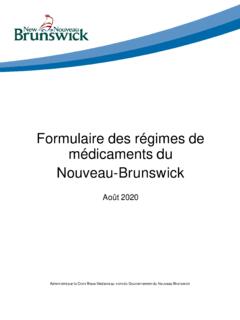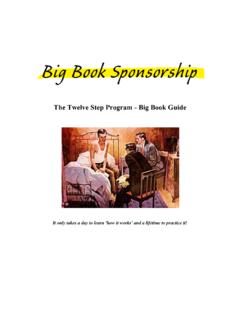Transcription of Supplemental Resource Guide - New Brunswick
1 # 840740 Personal Development And Career Planning Curriculum Grade 9/10 Supplemental Resource Guide Department of Education Educational Programs & Services Branch May 2002 2 Part 1: The 7 habits of Highly Effective Teens Teacher Note: The module on The 7 habits of Highly Effective Teens is to be covered in a maximum of 12 hours. The Guidance Curriculum Development Advisory Committee suggests the following activities from The 7 habits of Highly Effective Teens, The Ultimate Success Guide for Teens Teacher Resource Guide . The 7 habits of Highly Effective Teens, The Ultimate Success Guide for Teens has not been included as it is a consumable product. The following icons are placed beside various lessons to indicate: Key Lesson: Homework Assignment: %% Optional Activity: T Portfolio Activity: 3 Journal Writing options which may be utilized throughout the course: What are your good habits ?
2 What are your bad habits ? How do you feel when you choose to exercise a bad habit? Describe yourself as if you were writing a letter of recommendation. Write about what you look like? What are some of your favourite lyrics? Why do lyrics speak to you? Write about a time when you were in a leadership position. Describe yourself as a leader? Create a list of 7 habits for a Highly Effective Me. Note: Activities meet the following Personal Development and Career Planning Curriculum, Grade 9/10 Outcomes; Outcome ; demonstrate knowledge of the influence of a positive self-concept ; communicate and interact positively with others; demonstrate knowledge of the importance of individual growth for oneself and others; demonstrate responsible choices concerning home, school and the community; demonstrate responsible skills that lead a student to become a lifelong learner; demonstrate effective problem solving and decision making skills for personal and educational purposes.
3 Note: For additional communication activities refer to Career Studies 10, pages 84-93 or Teacher s Resource Career Studies 10, page121. Suggestion: The reading level of The 7 habits of Highly Effective Teens is appropriate for grade 9/10. Audio taped versions may assist struggling readers. 4 Introduction to The 7 habits (20 minutes) A. Have students write a definition for the word habit privately on their own. Divide the class into groups of 4-6 students, and have them share their definitions within these groups and arrive at a group definition of habit. Have students read page 8 of The 7 habits of Highly Effective Teens, What exactly are habits ? B. Have students cross their arms. Now ask them to do it the other way. How does that feel? Who taught them this habit? How long would it take to make them feel comfortable crossing their arms in this fashion?
4 (It takes about a month to learn or unlearn habits .) C. Dr. Stephen Covey and his son, Sean Covey, have organized good habits into these seven categories: 1. Be Proactive 2. Begin with the End in Mind 3. Put First Things First 4. Think Win-Win 5. Seek First to Understand, Then to be Understood 6. Synergize 7. Sharpen the Saw Have students turn to page 5 of The 7 habits of Highly Effective Teens and read and discuss each habit quickly. D. Have students list all the good habits they have acquired, and have them discuss these with a partner. E. Have students read The 7 habits of Highly Defective Teens on page 7 of The 7 habits of Highly Effective Teens and have them identify some of the bad habits they are practicing. Class Discussion: What can students do to become more effective teens? F. How can the 7 habits help? Have students turn to page 9 in The 7 habits of Highly Effective Teens and identify those habits they would like to improve upon.
5 Always do what is right. This will surprise some people and astonish the rest. Mark Twain 5 Paradigms Principles (40 minutes) A. Have students read the Top 10 All Time Stupid quotes on pages 11-12 of The 7 habits of Highly Effective Teens. Discuss the impact paradigm shift. Why are paradigm shifts important? B. Model-Building Activity (Note: Do it live or have a discussion.) If you put an airplane model together, what would you need? (Answer: Instructions.) What if the instructions were not for the airplane, but unknown to you, were actually instructions for a model train? What would happen if you attempted to assemble the model with these instructions? (Answer(s): You would become frustrated, you couldn t do it, etc.) The same holds true for paradigms . Sometimes we have an incomplete paradigm of a situation. C. Have students read the Paradigms of Life on pages 18-23 of The 7 habits of Highly Effective Teens, and in groups of 4-6, discuss the benefits and/or disadvantages of each paradigm listed.
6 D. Have students turn to pages 24-27 in The 7 habits of Highly Effective Teens and read. Ask students to list principles they want to use to build a firm character. %% If we work upon marble, it will perish; if we work upon brass, time will efface it, if we rear temples, they will crumble into dust, but if we work upon immortal minds and instill into them just principles, we are then engraving that upon tablets which no time will efface, but will brighten and brighten to all eternity. Daniel Webster 6 The Personal Bank Account (20 minutes) (The amount of trust and confidence you have in yourself) A. Have students read the paragraph entitled, The Personal Back Account on page 34 of The 7 habits of Highly Teens. Keep Promises to Yourself Have students answer item 2 on page 45 of The 7 habits of Highly Teens. Do Random Acts of Service Have students commit to acting on item 3 on page 45 of The 7 habits of Highly Teens.
7 (Students could write their commitment in their agendas.) Tap Into Your Talents Have students complete item 5 on page 45 of The 7 habits of Highly Teens. Be Gentle With Yourself Have students commit item 5 on page 46 of The 7 habits of Highly Teens. Renew Yourself Have students commit to acting on item 9 on page 46 of The 7 habits of Highly Teens. Be Honest Have each student describe a time when he/she exaggerated or embellished a personal happening to a friend or parent. Was this honest? What was the outcome of the situation? B. In their agenda on today s date, have students make a commitment to become more honest. Never look down on anybody unless you re helping them up. Jesse Jackson 7 habits Overview - Using the Tree Metaphor (20 minutes) A. Using the blackline master provided in The 7 habits of Highly Effective Teens, The Ultimate Success Guide for Teens, Teacher Resource Guide for Teachers (Appendix 3), make an overhead transparency of the 7 habits tree and go over the build-up of habits 1 through 7.
8 Have students turn to page 6 of The 7 habits of Highly Teens and follow along. Tell them in advance that they will have to teach a partner the seven habits in the correct sequence. B. Have students teach each other, one at a time. Each student should explain and complete the blanks on the tree diagram. C. Best Practices The 7 habits through Actions The following physical gestures emphasize each of the 7 habits . Habit 1: Be Proactive. Place thumb to your chest. Habit 2: Begin with the End in Mind. (point to your feet) with the End (both hands point to the mountain top) in Mind (point to your head). Habit 3: Put First Things First. Habit 4: Think Win-Win. Think (point to your head) Win (hand-out, palm open) Win (other hand out, palm open). Habit 5: Seek First to Understand, Then to Be Understood. Place hand over your brow like you re looking over the horizon, and then cup both hands behind your ears.
9 Habit 6: Synergize. Put your hands out toward opposite forearm and grab your forearm. Then shake your arms up and down like a mixer. Habit 7: Sharpen the Saw. Pretend you are sawing a tree with your hand. 8 Be Proactive (Habit 1) (60 minutes) A. Explain Reactive model. Refer to page 49 of The 7 habits of Highly Effective Teens. Proactive people make choices based on principle. Reactive people make choices based on feelings, their moods, emotions and impulse. In groups have students read scenes 1 and 2. Have them discuss each of the possible reactive and proactive choices and discuss the consequences of each choice. Have students read pages 51-65 and in groups identify 5 examples of proactive people and 5 examples of proactive language. B. What is the significance of Just Push Pause on page 65 of The 7 habits of Highly Teens? Quote: Between stimulus (action) and response, there is a space.
10 It is possible for us as individuals to develop this capacity to pause and give wiser responses. The ability to do that comes from the development and use of our unique human gifts. Stephen Covey C. Four Human Tools: This is a very important concept. Using this model, students can strengthen their proactive muscles. The 4 Tools are not separate steps: they blend together into one. Have students read pages 66-68 of The 7 habits of Highly Teens in groups of 4-6 and discuss the Four Human Tools : self-awareness, conscience, imagination, and willpower. Allow them to compare and contrast these tools in terms of human and animal behaviour. D. Optional Activity T We can control only one how we respond to what happens to us. Use the following example: Walk up to a student, (one who you know can take it!) who does not have green hair and tell him/her, Hi, (name), I really like your green hair.
